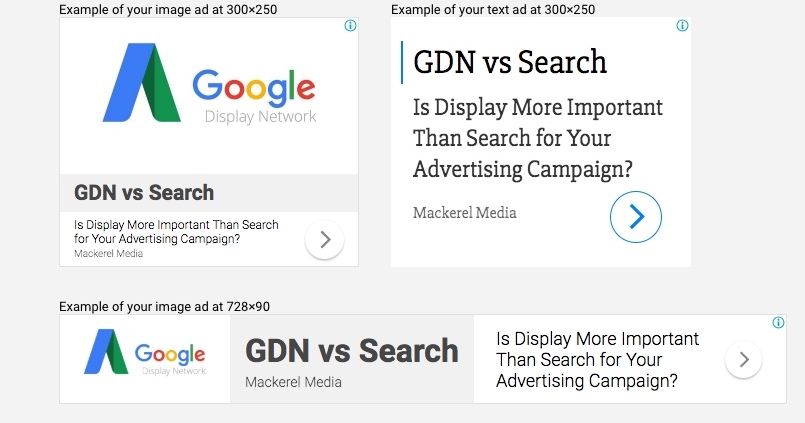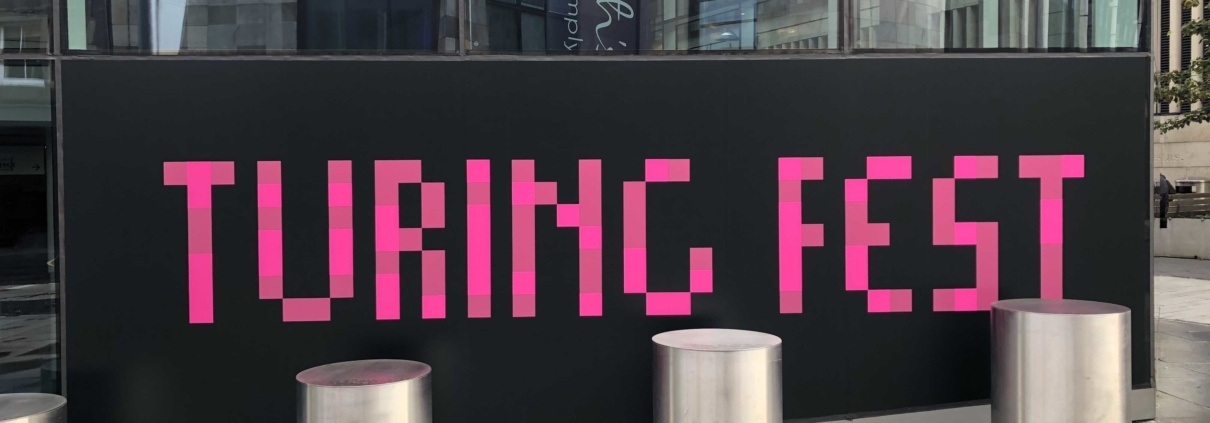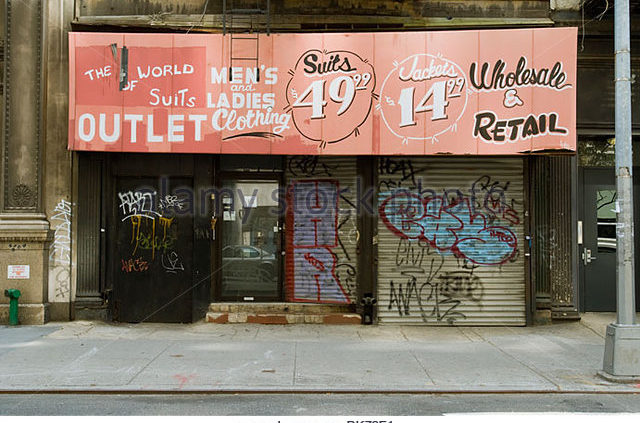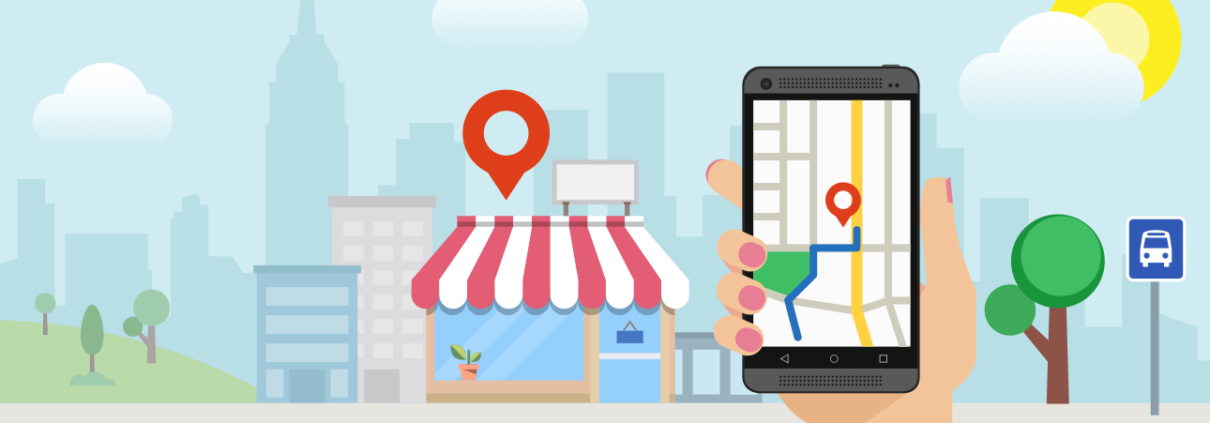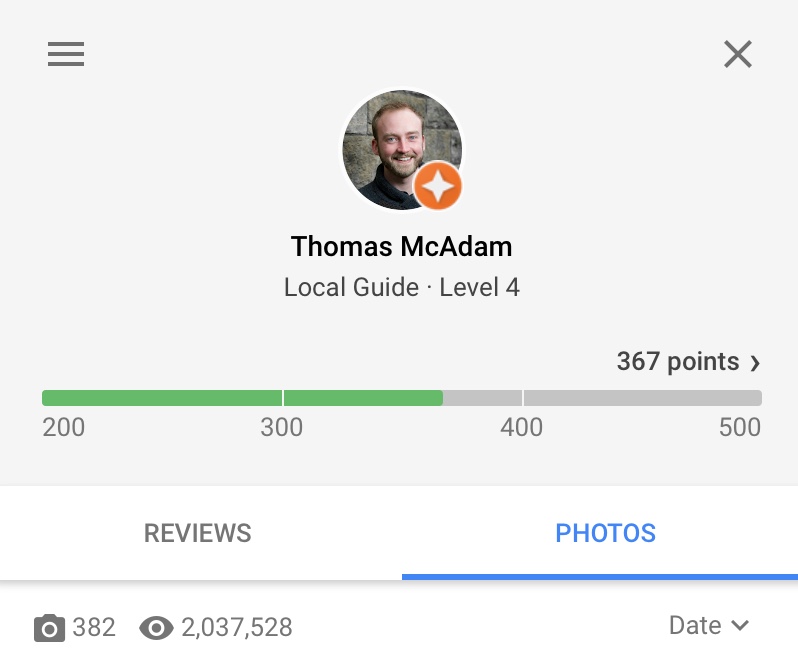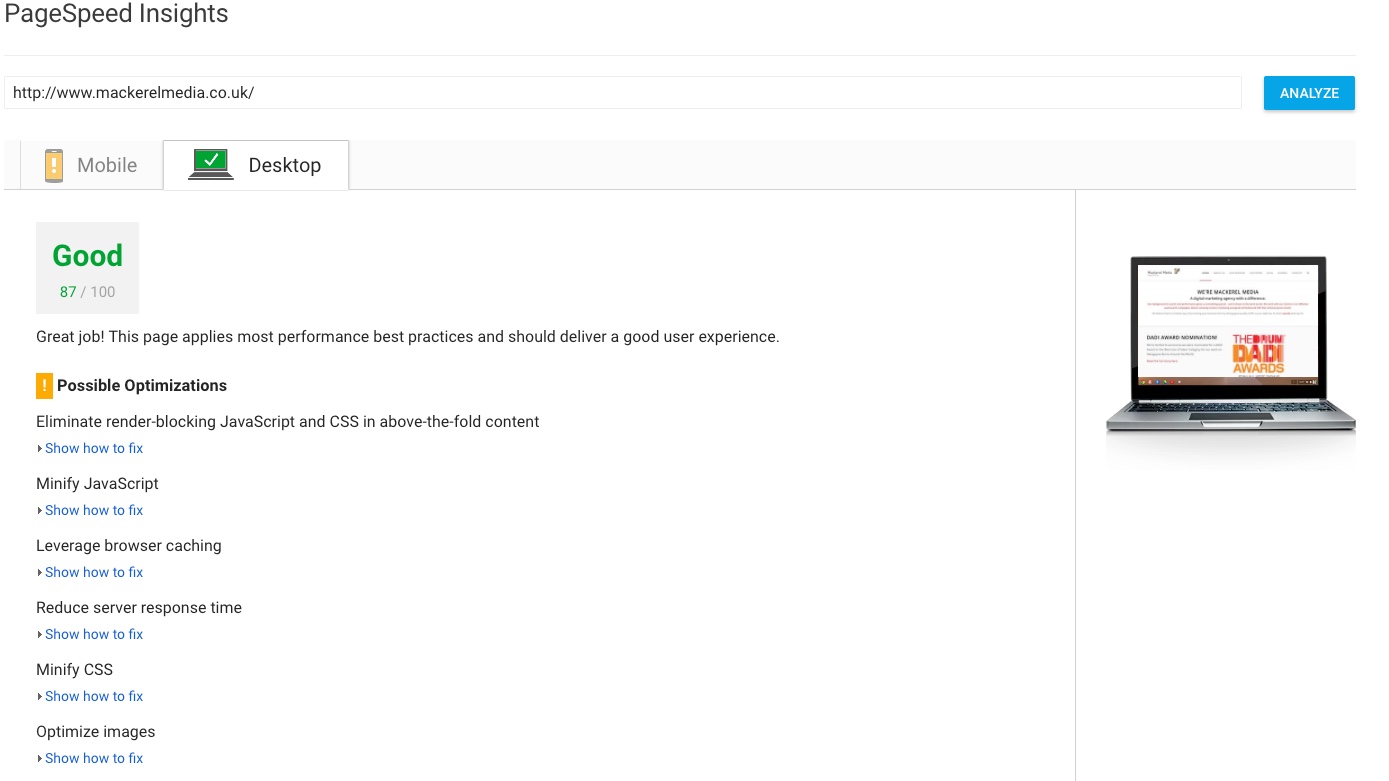We’ll Never Know How Google Ranks SEO (But It’s Vital to Keep Up)
On the 26th September 2002, Google released the first of its major search updates – Google Dance. The changes made to Google’s algorithm gave greater significance to anchor text quality allowing Google to increase the relevance of the sites it displayed when a user typed in a particular search query. Since then, Moz has documented a massive 170 Google Core Algorithm updates, with the latest ‘Medic’ confirmed as recently as August 2018.
It is important to remember that the likes of ‘Panda’, ‘Penguin’ and ‘Hummingbird’ – names every digital marketer should have heard before – are just the major search engine updates that are identified and confirmed by industry watchers such as Moz or Search Engine Land. In between these SEO seismic shifts, Google is constantly tweaking and refining its algorithms to make sure users get the best possible results for their query. John Mueller, Google’s Senior Webmaster Trend Analyst, has even gone as far as to say “Google makes changes almost every day”. That’s’ a lot of updates to keep up with!
Google’s Web Page Ranking Factors
With between 500 – 600 Algorithm updates happening each year, you might not be too surprised to hear that there are an estimated 200 factors that can influence how Google ranks a page. Unfortunately, Google has never outright confirmed what any these ranking factors actually are – often hints are given or senior members of Google teams say something cryptic, only for SEO agencies to spend weeks trying to decode new SEO ranking methods to give their clients an edge in the SERPs.
What we do know however, is that the majority of SEO ranking factors are likely outside the influence of SEO agencies or businesses. This means that the elements we can affect – such as keywords, backlinks and technical elements – are incredibly valuable to SEO work and can have a huge effect of the ‘success’ of a web page.
So, What Can We Directly Influence?
As is becoming clear, your website’s page rank is a complicated matter. When a digital marketing agency talks about how to improve your organic traffic, they’re likely thinking about at least three distinct strategies that are covered by the term ‘SEO.’
On-page is the most common form of website optimisation – and the one you probably think of when talking about SEO. Is your content unique, relevant and interesting to the user? Does your content add something new to the web? Does every page have its own unique page title, meta description and content? Are your pages correctly structured, with all images given Alt Tags?
Technical SEO covers how the site itself is structured & presented to promote a positive user experience. Google considers page load times, server response times, mobile device compatibility, Ref-Lang tags, canonicalisation and other criteria for an overall ‘health check’. Chances are if your keyword optimised website is still struggling to rank, it’s a technical SEO problem holding you back.
Finally, a SEO agency will consider your backlink profile. This where other websites – such as bloggers, industry recognised websites and even other businesses – provide a link from their website to your website. Google sees this as a vote of confidence (indeed backlinks are a core part of the founding PageRank principles of the search engine) and can help increase your overall authority. This is without doubt a hugely effective way of improving rankings.
Your SEO Is Out of Date
Last year, I wrote how SEO isn’t Dead– and concluded that on-page refinements to your SEO can still have significant impact on how your page is ranked by Google. Twelve months later, and I’m more convinced than ever that ongoing SEO work is the cornerstone of all online digital marketing activity.
With so many changes being made to Google’s algorithms every single day, ask yourself this question – when was the last time your website was optimised? John Mueller (that name again) recently revealed the importance of domain-level authority metrics, sub-domains & algorithm changes that Google now considers important ranking factors.
So, if you’re reading this thinking “well I optimised my site last year”, your page might already be lacking some SEO signposts that Google now considers to be important to Page Rank.
Of course, I’m not about to suggest that your website needs an entire SEO audit every couple of months – in fact, the stability and age of a webpage is often cited as a contributing factor to search engine rank. However, it is important to make sure that your pages are as optimised as possible for Google’s ever-changing algorithm, and that means making SEO work part of your day-to-day digital marketing strategy.
If you need to optimise your website, Mackerel can help! Get in touch today at hello@mackerelmedia.co.uk.
Is Display More Important Than Search for Your Advertising Campaign?
In the lead up to GDPR, one of the things that came up most when chatting to our clients was whether or not the Google Display Network – and display marketing in general – was suddenly going to be unusable in their digital marketing strategies. Amongst the hundreds of articles, blogs and tweets discussing the effects of GDPR on display advertising I came across an article claiming that the era of the Display Ad was at an end.
In a nut-shell, the article suggested that internet-weary consumers are becoming less receptive than they used to be to the so-called “interruption-driven” model of visual-based ad servers. This can lead to an effect known as ad fatigue – the“numbing” of users to your marketing efforts over time.
Ad-fatigue can affect display marketing campaigns, but it can also be seen with search marketing and even traditional platforms like print and television advertising. So why aren’t we reading more articles foreshadowing the death of advertising across all of these mediums?
While I don’t completely disagree with the report’s conclusions, I find it difficult to accept the idea that an entire subsection of digital marketing is dead – especially given that I keep seeing display marketing success stories here at Mackerel Media. I suspect people just don’t realise the huge potential of Display Network advertising has for most businesses when used correctly.
Building Brand Awareness with GDN
For the most part, advertising campaigns which rely on the Google Display Network are used for building Brand Awareness across the internet.
Let’s build a worst case scenario: an e-commerce business using just one piece of ad-creative across the entire Google Display Network in a “scatter-gun” fashion. Whilst the adcopy may be “on-message” for our brand, this method would mean Google could theoretically place our advertising banners or MPU’s wherever there is display inventory available, regardless of the page’s topic or our advertiser’s desired outcomes.
As any digital marketing agency worth their salt will tell you, this is an extremely inefficient use of your campaign budget – supposedly $7.4bn was wasted on Display in 2016 – and one that is unlikely to bring any real success. Plus, even in our hypothetical scenario, we’re still at the mercy of user-apathy and the dreaded Ad-fatigue.
For this all too common situation, the report is correct – this type of “anything & anywhere” display advertising campaign has already come to an end – today it is more difficult than ever for marketers to create this type of campaign on the GDN, and other display networks are beginning to follow suit.
Opportunities for Brand Activation
The implicit message of the report – which highlights that the average display network CTR is only 0.35% – is that display adverting doesn’t receive enough clicks, and a low CTR means that a campaign is failing.
On the Google Search Network – which determines intent via a user’s search query – such a low CTR would often (but not always) be cause for alarm. Due to the very nature of display campaigns however, impressions are often very high – after all, there are near unlimited websites where an advert may be chosen to appear. With this in mind, I’d argue that 0.35% is a positive performance for any display campaign.
Don’t forget, there is a myriad of targeting options that allow your display campaign to reach a better defined and more effective audience, thus increasing the likelihood of a user clicking your banner advert or MPU. Google AdWords users can target specific page placements (such as ones you know your key audiences frequently visit), topics that relate to your services or even product keywords.
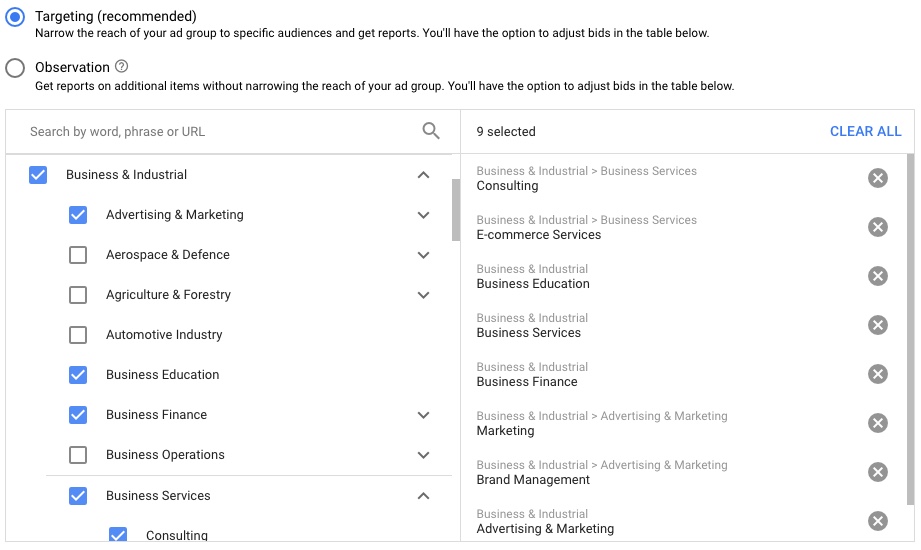
Google’s Display Network targeting options have become more sophisticated than ever.
It’s All About “Where” and “Who”
Let’s use one of Mackerel Media’s own clients as an example: Working in a competitive market space, CTR for our client Display network campaign was 0.21% – lower than the 0.35% identified as being “not enough”. An important factor here however was wherethe adverts appeared on the Google Display network – Placement Targeting had allowed us to identify and target websites which were frequented by internet users who had been identified as “most-likely-to-convert”, whilst Google’s Affinity Placements automatically chose similar websites to further increase our reach whilst still remaining within our target “converting” audience. At the same time, multiple ad-creatives were offered to combat the effects of ad-fatigue on impressions – each with a slightly different USP.
This large-scale, targeted Display Network advertising campaign with multiple pieces of adcopy available across an 18-month period resulted in around 10,000 clicks to our clients landing pages. Our total spend during this campaign was about £8,000, giving an Average £/Click of £0.80. For the same number of clicks on the Search Network, where an extremely competitive market means CPC is higher at around £2.00, 10,000 clicks to site would have cost an eye-watering £20,000 – a massive increase in cost for the same amount of traffic to the same landing pages.
Here we can see that a properly targeted display campaign with engaging creative can allow any company to successfully reach a large number of potential customers with a relatively low CPC. The message here is that getting in front of the right audience will trump large impression numbers any time.
Quality not Quantity
We can see that a properly targeted display campaign with engaging creative can allow any company to successfully reach a large number of potential customers with a relatively low CPC. The message here is that getting in front of the right audience will trump large impression numbers any time.
What the report fails to acknowledge – and something that our clients have been pleased to hear – is the use of audiences, dynamic and remarketing campaigns that take advantage of the Google Display Network’s ability to accurately track users across their web journeys. Even post- GDPR, we can learn a huge amount about a users behaviours, interests and most importantly – their intentions.
With careful analysis of our targeting options and user behaviour, we can make sure that a user – whether they’re brand aware or not – see’s your advert at the right time, and the right place for them to make those key decisions that benefit your business.
Mackerel Media isn’t ready to give up on Display Advertising just yet.
AI & Voice Searches: The Future of Digital Marketing?
Last week, the digital marketing world descended on Mackerel Media’s hometown of Edinburgh for Turing Fest 2018, and we were there to bring you the latest developments in digital marketing!
Across six digital marketing experts – one clear theme emerged time and time again: Google’s growing fondness of AI lead search results, specifically the use of voice recognition technology and the effect it will have on how we as digital marketers are able to advertise clients in the changing Search Engine results space.
While the scale of voice searches is a bone of contention between digital marketers – even here in the Mackerel office there are differing opinions on how commercially useful they actually are right now– one thing is undeniable: with the growth of ‘smart’ voice assistants such as Apple’s Siri and Amazon’s Alexa, 50% of all searches made by 2020 are expected to be initiated by voice and powered by machine learning.
Just Sayin’
Why is there such a push towards voice activated searches? Well, according to Cindy Krum, one of Turing Festivals Marketing Track speakers, it’s simple: Google wants to rank more than just websites and present result in a way personalized to your interests.
This makes a lot of sense, and Google has already begun using AI systems to start organizing which videos you see on YouTube, which Apps get returned to you when you do a search and can even allow you to do smart searches through your photographs stored in the cloud.
To allow this to happen, Google has had to change the way it thinks about the information it stores, and how it organizes that information. Whereas previously, Google grouped information together based on the words and phrases a website contained, in a world where not every bit of information a user is searching for has a website, Google has had to change tact – and it’s doing it via AI that you and I are helping to program.
Jes Scholtz – another Turing Fest 2018 speaker – points out that we’re constantly helping to tweak machine learning systems into better understanding what it is we’re looking for, and we may not even realise it. Those thumbs up and thumbs down icons in Netflix? Each time you give a rating you’re helping Nextflix refine its algorithm designed to show you the content most relevant. Same goes with Gmail’s “Mark as Spam” button. None of this is new, but the way in which the data is interpreted is – the massive scale of data gathered plus the application of AI to incorporate many other signals such as the time of day you hit thumbs up, or where you are when you hit ‘Mark as Spam’ leads to a massive improvement in the quality of the algorithms.
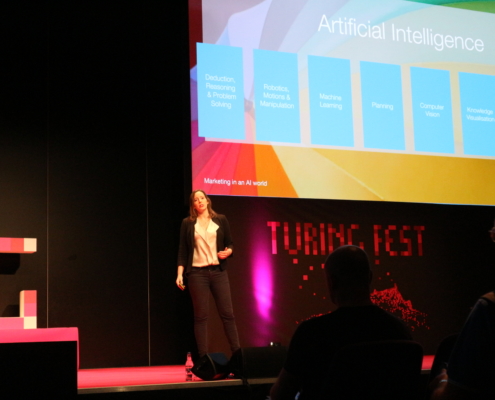
Jes Scholz discussed the importance of Marketing in an AI World.
The End of the Website as We Know It?
So how does this relate to Voice Search? Well, traditional search engine results pages just aren’t suitable for devices that use voice technology to provide results to a query. Nobody wants to ask Alexa for places to buy a certain item only to be confronted with a list of 20 webpage URL’s read out one… letter… at… a… time…
What voice activated search results need to do is determine the most relevant piece of information for that search and return it right there and then, and they’re doing it through machine learning and combining that with their vast understanding of a users personal history, interests, behaviors & search intent.
We’re already seeing this type of ‘definitive information’ result being surfaced in the form of knowledge panels, direct answers in the SERPs and informational sidebar results. According to Cindy Krum, this type of search result has grown more prominent with mobile and voice results containing a knowledge graph answer climbing from 35% in 2016 to 60% in 2018.
Clearly, Google is putting a lot of emphasis on this type of result. Google’s end game, according to Cindy Krum, is allowing Google to become “the presentation layer of the internet”– soon, we might not need to see a product website to be able to buy, we’ll just do it directly through the Google results.
Good news for voice assisted searches, bad news for websites.
Hey Siri, What Do I Do Next?
The biggest question you might now have is how do we prepare for a world in which Google might not even consider our website before providing just one answer to a voice search?
One of the most interesting speakers at Turing Fest 2018 was Yoast’s very own ‘Mad Scientist’ Jono Alderson – who joined us on stage to explain how brands need to learn some important lessons from the pre-digital marketing era in order to succeed in the future.
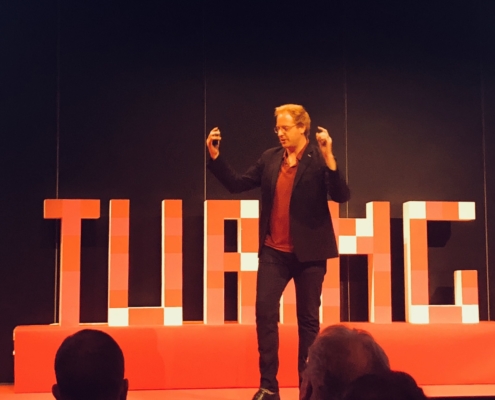
Yoast’s very own Jono Alderson describes the power of ‘brand currency’.
Big brands have always relied on ‘story telling’ and relationship building with customers to position themselves at the forefront of their mind when decision making, and that is how brands of the future are going to stand out from the voice-search crowd.
Brands need to start thinking about how future customers may want to interact with their brand months or even years before the searcher even knows they want to buy a product. If Google knows a user has a documented history of interacting with a brands content, social media, pictures or other media, the more likely they are to consider that brand for a user’s personalised search result. The more a user knows and cares for a brand they’re presented with by Siri as a single voice-search result, the more likely they are to explore that search result further.
Jono Alderson calls this ‘brand currency’, and it’s invaluable in a world where AI powered voice search is dominant. If a searcher has no affinity with a brand, they’ll just search again and you may have missed the only opportunity you’ll have for that user to interact with your brand. What’s worse, is that Google could use its machine learning and AI to update its algorithm and push you out of that individual users ‘pool’ of potential search results in the future, having marked you as not of interest to the user.
How Do I Even Appear for Voice Searches?
It’s clear that Google see’s the future of search as hyper-personalised, AI driven results where even a single interaction with a brand can influence how a user is presented information, but we still need to make sure that we’re even eligible to be considered by a voice-search engine in the first place.
Thankfully, Google has already given us a suite of tools and platforms designed to specifically do that: Google My Business, Knowledge Graph results, Google Maps and a whole host of technical tools such as Schema Mark-Up and the Google Natural language API tool.
In a world where ‘on-the-go’ searches are becoming increasingly familiar – and where Google is able to collect vast quantities of data on the brands you interact with and what your feelings towards them are – what becomes the defining factor of whether a search result is presented or not is relevancy. Google now considers these ‘supporting’ pieces of information to be just as important – if not more so – than the content of a website or the products a brand sells.
If I do a voice search for “French restaurants near me”, guess what? The one which has its opening times and address listed on GMB is the one that a voice-assistant is going to return as my answer, because that’s the one I’m going to be more likely to go to. The same goes for e-commerce businesses which provide clear product prices or service providers who produce great knowledgeable content about their specific offerings. Again, Google is cutting out the middleman and giving us just the answers it thinks we want to see.
Do We Really Think This is the Future of Search Marketing?
To put it bluntly, if this is what Google is saying the digital marketing landscape is going to look like in the future, then it’s worth making sure we are prepared for a world where voice-searches overtake traditional text-based queries.
For the most part though, brands which take their digital marketing activities seriously needn’t worry too much. All of the tools Google has indicated may tip the balance of one search result appearing over another – such as Google My Business or Mark-up Schema – have already become part of most really good digital marketing strategies, and are easy to set up should you have forgotten.
Why is a Great Landing Page Important for Your PPC Campaign?
In the grand tradition of all digital marketing blogs, let me start by giving you an offline scenario that we can all relate to “IRL”: you pass a billboard in the street which is advertising the perfect gift for your partner. The billboard tells you everything you need to know about the product and you decide to buy it right there and then. You arrive at the only shop in town selling the item to find it half-boarded up, with broken windows and a missing sign. Worse still, there is a suspicious character hanging around outside eyeing you up and down. Even if the perfect gift is inside that shop, what do you do? You turn around and look for something else.
Your paid search marketing campaign could well be that billboard we saw – informative, memorable, relatable and with a great call to action. But the formatting of your landing page is slightly off on mobile devices, there are spelling mistakes in the headings and you have a non-secure submissions form triggering alerts in the user’s browser. You might as well be stood outside that store in a rough part of town.
First Impressions Matter More Than Ever
Landing Pages are crucial to any digital marketing campaign. They are the first real opportunity you have to introduce your business, or the products you sell. A great landing page can cause a user to convert on their first visit, whilst a poor one can leave a lasting negative impression that’s hard to come back from – 79% of dissatisfied customers won’t visit your site again. Pushy sales language, irrelevant content and pressuring your visitors into submitting personal information such as email addresses can be enough to drive your traffic away for good.
Landing Pages Affects PPC Quality Score
Poor landing pages can also have a direct effect on the success of your paid search campaigns. Each PPC keyword you bid on in Adwords is assigned a Quality Score out of 10. While there are many, many factors that are taken into account by the Google Algorithm, effectively quality score is a rating of your keywords relevancy to a user’s search term and the landing page you direct them towards.
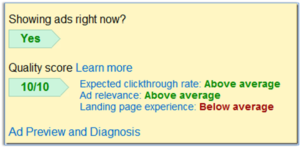 If a user searches for shoes, but your advert takes them to a landing page about coats, they’re unlikely to convert. Not only are you going to see a lower ROI in this scenario, but Google will eventually realise that your landing page has little relevancy to the keywords you bid on and punish you by lowering your Quality Score: there’s lots of evidence to suggest that lower quality score means a higher £/click and a lower Ad Position in the search engine results pages.
If a user searches for shoes, but your advert takes them to a landing page about coats, they’re unlikely to convert. Not only are you going to see a lower ROI in this scenario, but Google will eventually realise that your landing page has little relevancy to the keywords you bid on and punish you by lowering your Quality Score: there’s lots of evidence to suggest that lower quality score means a higher £/click and a lower Ad Position in the search engine results pages.
What makes a Great Landing Page?
Simply put, when a user arrives on a landing page after clicking your link, it should be immediately clear they have arrived in the right place. All the information that they need to make their decision should be freely available to them in a friendly, clear and concise way with a powerful CTA. A great landing page will be technically sound too – fully mobile responsive, formatted correctly and with a clear focus on security.
In the age of the internet, people want instant gratification – and if your landing page doesn’t immediately offer a user the information they are looking for, then you have already lost their interest. Remember – without the perfect landing page your customers aren’t going to care about what you have for sale, they’re just not going to get past the state of your shop front. As the old saying goes: first impressions really do matter on the internet.
The Value of Being Seen
Here’s a question: What value do you put on your business being seen by prospective customers?
Most of you will agree that the first thing you do these days when looking for a product, restaurant, or business is turn to Google. Working in digital marketing and specialising in local search has shown me two things: how effective it is to be fully present to your target market, and how few businesses utilise this free tool to make sure every possible user can find them.
Having a Google My Business listing allows you to present key information to customers, convincing them to continue to the website or contact you for more information. The best way to engage a user is through images. We’re told not to, but everyone judges the book by its cover, and business listings are no different. So why not make your business ‘cover’ the best it can be?
Power Of The Masses
Google has realised that a lot of business owners either don’t have the time, or just don’t know, to fill out their business listings. This is probably why they created the Local Guides community, allowing locals to not only leave reviews but to contribute edits or add to missing information on local business listings.
Out of intrigue I joined the Google Local Guides back in May 2016 and started adding pictures and reviews to the places that I had been.
As a digital marketer I found it fascinating that Google was now ‘Crowd Sourcing’ local business information. Obviously, for me there was a professional benefit here, to find out the information that Google was wanting to gather before making it available as an attribute on listings.
Having now contributed reviews, photos and verified other Local Guides’ information, I’ve worked my way up the Levels Google put in place unlocking different features along the way. One of my favourite features are the questions that Google asks about the places you’ve been, such as accessibility or what the place is known for. So much information has already been gathered that recently, Google has used the questions that it’s gathered from the local guides to add it’s Attributes feature to Google My Business.
“Google My Business Listings with photos and a virtual tour are twice as likely to generate interest.”
This brings my back to my original question of the value of a prospective customer and how they see us. While writing this article I surpassed 2 million photo views, and though the views aren’t for one particular business, there are some heavy-hitters who have seen traffic as the main image shown for their listing.
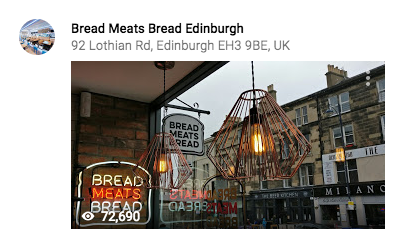 From restaurants to distilleries and museums, customers want to be able to see what’s there before arriving, so why not make sure you populate your listings with professional imagery that generates interest in visiting?
From restaurants to distilleries and museums, customers want to be able to see what’s there before arriving, so why not make sure you populate your listings with professional imagery that generates interest in visiting?
To truly give customers an immersive experience before arrival Google’s integration of its Street View app has even made it possible for Local Guides to contribute 360° photos to a listing.
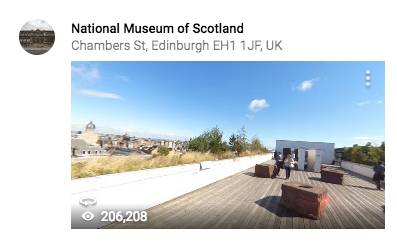 Doing so and contributing over 50 approved images then leads to becoming a Google Street View Trusted Photographer (which I happen to be), allowing photographers to transfer the rights/ownership to Businesses.
Doing so and contributing over 50 approved images then leads to becoming a Google Street View Trusted Photographer (which I happen to be), allowing photographers to transfer the rights/ownership to Businesses.
So whether it’s a photo of items on your menu or a 360° of your roof-top terrace, make sure that your business listings show your potential customers everything your business has to offer, and you’ll be rewarded with more visits and more customers.
Why does a fast page load time matter?
Most people who work day-to-day in digital marketing know that the inner workings of the Google PageRank Algorithm are mostly a complete mystery. Whether or not your webpage will appear on the SERP’s is decided by a mind-boggling 200+ factors.
Thankfully for us here at Mackerel Media, there are a number ranking factors under our control that the industry (almost) always agrees can make a difference to how your site will be ranked by Google. It’s likely that you’ve already optimised your site for keywords or authority-giving links, but have you thought about how important page speed is on today’s fast paced, on-demand and mobile-focused internet?
Web Pages are Bigger than Ever
According to a recent study, the average page served today is 3.5 times greater than in 2010 – a whopping 2.5MB of code, advertising, images, videos and other rich media that needs to be loaded onto your device before you can watch the latest viral cat video or discover which type of meatball you should be on Buzzfeed.
And while slow load times can be infuriating on desktop computers, on mobile devices page load time being anything less than instant can actually be damaging. Google itself shared data with the industry that suggested 75% of mobile device users would abandon a webpage if it takes longer than 5 seconds to load, and 79% of those dissatisfied customers won’t visit your site again. Ad blockers have been on the rise in no small part due to this particular problem, but that’s a blog for another day!
A Lesson from Google
Google certainly learnt this the hard way. During a Web 2.0 conference in 2006, Marissa Mayer highlighted that a 0.5 second increase in SERP load-time resulted in a 20% decrease in traffic. That’s right, half a second was enough for the worlds most visited webpage to lose a fifth of its traffic.
If that wasn’t enough of a reason to make sure your webpage loads as fast as possible, then let me introduce you to the Gap of Death theory. This rightfully scary-sounding concept is the name given to the time between a webpage users load-time expectations and the actual time a page takes to load. For each additional second a user waits you can expect your conversion rate to drop by 7%, according to some research.
A 7% loss in conversions per second is a nightmare scenario for any business, especially ones that rely on e-commerce websites. Amazon.com techie Greg Linden blogged about the results of internal A/B testing that suggested even very small delays can “result in substantial and costly drops in revenue”.
The Paid Search Contagion
While the effects of page speed are intricately tied to your organic performance, a slow load time can also affect your paid digital marketing efforts too… sorry. Right here in the AdWords support documents, we can see that “landing page experience” and specifically “landing page load time” can have an effect your overall AdRank – and in turn your average advertising costs and ad position.
Now that we know the damage a slow loading page can cause to a business, what can we do to increase page speed?
With desktop, the answer is to keep an eye out for bottle necks and reduce their impact – bloated web pages, poor hosting services, 301 redirect chains, analytics code, slow widgets and plug ins or incompatible media. If you suspect that your webpage load time is too high, these are the usual suspects.
AMP to the Rescue?
Mobile sites have a smarter answer – Accelerated Mobile Pages or AMP. The AMP Project is designed to give users a great mobile experience no matter what platform their mobile device is loading web pages from. In essence, AMP pages have found success by augmenting the HTML code that powers a web page and pre-loading as much content as possible using standardised formatting before the user ever clicks on a link. The result is a page which appears to load instantly.
Unsurprisingly, Google is a huge fan of AMP pages – even allowing web developers to identify their pages with SERP friendly discoverable <”amphtml”> tags. However, whilst take up has been quick and widespread, some in the industry who have worked with or have knowledge of the tool for a while are not entirely fulsome in their praise. One commentator reported a bug in AMP that apparently risks inflating Unique User counts four-fold which would cause enormous issues for major publishers. Others were concerned that AMP Pages ‘masked’ the publishers’ URL making it harder for users to either identify the publisher or share a link to the article, but to its credit Google responded by changing AMP behaviour to ameliorate the concern.
So what does all of this information teach us? Simply put, slowly loading web pages can reduce the likelihood of a user ever reaching your site, and massively decrease the chances of them completing one of your conversion goals if they do.
In the end, how well your online business channels perform is down to how quickly your pages load. As Marissa said in her 2006 Web 2.0 talk, “Users really respond to speed.”


